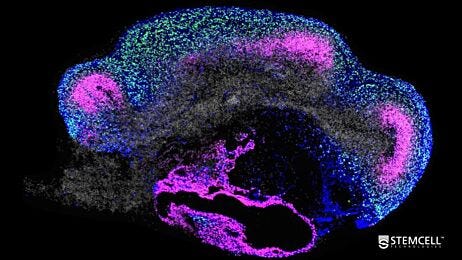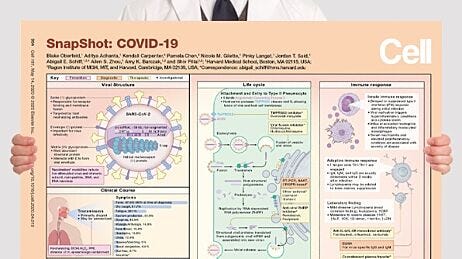A Year in Review: Our Favorite Science of 2020
SARS-CoV-2, Pulmonary Research, CRISPR, and Beyond

The scientific landscape has shifted dramatically in 2020 as researchers worked earnestly to study SARS-CoV-2. While significant research efforts have been placed on resolving the COVID-19 pandemic, exciting discoveries continued to be published in other areas of life science research. This year, the scientific community also celebrated the discovery of CRISPR-Cas9 as Dr. Charpentier and Dr. Doudna received the Nobel Prize in Chemistry. Here at STEMCELL, we are continuing our tradition of sharing some research discoveries that inspired, surprised, and delighted our scientists throughout the year. I hope you enjoy our 2020 selections.
Dr. Sharon Louis - Senior Vice President, Research and Development
Science Selected by Scientists

Dr. Catherine Ewen’s Favorite Science of 2020
Senior Scientist
Immunology
A Novel Coronavirus from Patients with Pneumonia in China, 2019
Zhu et al. was the first to identify and sequence the causative agent of COVID-19. The group was able to demonstrate that this novel virus could infect and propagate in human cells by using primary airway human epithelial cells, rather than traditional cell lines. This approach resulted in the generation of the first viral genomic sequencing data of SARS-CoV-2, which was subsequently shared with the greater scientific community. The sequencing data were used to develop critical COVID-19 diagnostics and became the groundwork needed to expedite vaccine development at a speed that has never been previously achieved. Read the paper >
Rapid Isolation and Profiling of a Diverse Panel of Human Monoclonal Antibodies Targeting the SARS-CoV-2 Spike Protein
Using samples from convalescent COVID-19 patients, the Crowe Lab at Vanderbilt University elegantly demonstrated the use of a rapid antibody discovery platform to identify therapeutic antibody candidates. Their work, along with Cao et al. (2020), highlighted the use of single-cell sequencing and bioinformatic techniques to identify monoclonal antibodies reactive to SARS-CoV-2. Their studies confirmed that antibodies against the RBD region of the spike protein were highly effective at neutralizing SARS-CoV-2. Promising monoclonal antibody gene sequences were cloned into cell lines, and antibodies were characterized using in vivo models. We have seen enormous acceleration in antibody discovery due to new technological advances, generating considerable interest and investment over their potential to help combat infectious disease. Read the paper >
Antigen-Specific Adaptive Immunity to SARS-CoV-2 in Acute COVID-19 and Associations with Age and Disease Severity
Researchers Shane Crotty and Alessandro Sette at La Jolla Institute for Immunology have published a series of seminal papers measuring the adaptive immune response to SARS-CoV-2. In this paper, the authors used a “mega pool” of predicted T cell peptide epitopes and flow-based techniques (activation induced markers) to quantitate and characterize antigen-specific T cell responses from individuals who had recovered from mild COVID-19 disease. Their findings suggested that, unlike the dominant antibody responses to spike protein, T cells were also reactive to additional viral proteins/ORFs. Furthermore, T cell reactivity to SARS-CoV-2 epitopes were also detected in a few non-exposed individuals, raising questions on whether these T cells could play a protective role in some individuals. Read the paper >
Impact of SARS-CoV-2 Infection on the Central Nervous System
Learn about potential neuroinvasive and neuroinflammatory implications of SARS-CoV-2 infection in this webinar by Eric Song.
SARS-CoV-2 Viral Diversity: Causes, Consequences, and Opportunities
Discover the differences in virus genotype and how they can impact viral load, transmission, and spread in this webinar by Dr. Judd F. Hultquist.

Dr. Douglas Kondro’s Favorite Science of 2020
Scientist
Microtissue Scale-Up
Generation of Model Tissues with Dendritic Vascular Networks via Sacrificial Laser-Sintered Carbohydrate Templates
Jordan Miller’s team consistently produces outstanding publications highlighting the core of biomedical research: the intersect between engineering and biology. In this paper, vascular networks were produced using 3D-printed, laser-sintered, carbohydrate vessels that would then be “sacrificed” to produce hollow lumens. This process is capable of producing incredible channel complexity where the sacrificed carbohydrate structures allow for the establishment of an endothelial layer of cells in the vessel. As a whole, the process offers an approach to vascularizing engineered tissues. Read the Paper >
Multivariate Patterning of Human Pluripotent Cells Under Perfusion Reveals Critical Roles of Induced Paracrine Factors in Kidney Organoid Development
In cellular biology we are often “spoiled for choice” with the number of factors to test in a given experiment. The authors of this work devised a high-throughput microfluidic device that they used to grow 3D kidney organoid structures. The device allowed for hundreds of unique tests to be completed with minimal user input while using accessible imaging techniques to quantify the organoids in the system. This article demonstrates a workflow applicable to a wide range of tissues by navigating complex experiments and arriving at an optimized condition. Read the Paper >
Stirred Suspension Bioreactors Maintain Naïve Pluripotency of Human Pluripotent Stem Cells
An excellent paper published by the Rancourt lab in Calgary, Alberta—a group I have previously collaborated with. By directing PSCs towards a naïve state, the authors were able to demonstrate an improved expansion rate in suspension cultures while maintaining their pluripotency. This work addresses the important challenge of scaling-up PSC cell sources that can be used as a building block for downstream differentiation. Read the Paper >

Dr. Johanna Finn’s Favorite Science of 2020
Scientist
Pulmonary
Inflammatory Signals Induce AT2 Cell-Derived Damage-Associated Transient Progenitors that Mediate Alveolar Regeneration
Alveolar Type II cells are the regenerative stem cell population in the alveoli, the gas-exchange portion of the lungs. For several decades, scientists have known that Type II cells are able to differentiate to Type I cells in order to regenerate after lung injury, but there is still a lot that remains unknown about the transition from Type II to Type I cells. In this paper, the authors used single cell RNA sequencing to map the transition from Type II to Type I cells and identify a subset of Type II cells (DATPs) that constitute a transient intermediate that is prevented from fully differentiating to Type I cells if inflammation persists. Read the paper >
Persistence of a Regeneration-Associated, Transitional Alveolar Epithelial Cell State in Pulmonary Fibrosis
Related to the above paper, this paper also identifies an intermediate cell type between Type II and Type I cells that is responsive to TP63, is more vulnerable to DNA damage, and shows hallmarks of senescence. These PATS cells were found in higher numbers in the lungs of advanced pulmonary fibrosis patients, a disease which has no cure. Whether the PATS population is the same exact population as the DATP population in the paper above remains to be determined, but further understanding of PATS and DATP cells could have significant implications for pulmonary fibrosis research and treatment. Read the paper >
Human Lung Stem Cell-Based Alveolospheres Provide Insights into SARS-CoV-2-Mediated Interferon Responses and Pneumocyte Dysfunction
Use of human stem cell-derived organoids is relatively new in the lung biology field. Katsura et al., as well as several other groups, have found that stem cell-derived lung organoids are a useful model system for many lung pathologies, including COVID-19. In this paper the authors show that lung organoids express the SARS-CoV-2 co-receptor ACE2 and identified IFN-gamma as a potential therapeutic target for COVID-19 treatment. Read the paper >
Studying Viral Infection with ALI Cultures
Learn what makes ALI cultures a physiologically relevant model system and explore how researchers are using them to study viruses, including the novel coronavirus.
Respiratory System Overview
Get a free wallchart providing an organizational and functional overview of the respiratory system.

Dr. Mark Romanish’s Favorite Science of 2020
Senior Business Development and IP Officer
Species-Specific Segmentation Clock Periods Are Due to Differential Biochemical Reaction Speeds
Significant strides have been made to understand the reason for different developmental tempo among mammals. The Ebisuya group at EMBL Barcelona studied mouse and human interspecies differences by recreating segmentation clocks in species-specific iPS cells. Assessments at the orthologous core locus of the segmentation clock, HES7, determined that the differences are not due to distinct nucleotide or protein-coding sequences. Rather, biochemical reactions that increased protein stability and cell cycle in human cells correlated with a twofold slower rate of human cell differentiation compared to mouse cells. A companion article by Rayon et al. in the same journal issue substantiates the Ebisuya group’s conclusion using a different system. Read the copy >
Extensive Germline Genome Engineering in Pigs
Generation of xeno-transplantable organs may have taken a big step toward reality. An international collaboration of research groups exploited CRISPR-Cas9 and transposon technologies to produce engineered pigs with three deleted porcine xeno-antigens and with a number of human transgenes to aid in immunological compatibility. In addition, the pigs were engineered with inactivating mutations to coding-competent and potentially virulent copies of porcine endogenous retroviruses present in their genome. Overall, this work may enable xeno-transplantation of pig organs into humans, which have previously been prone to rejection. Read the paper >
Transient Inhibition of mTOR in Human Pluripotent Stem Cells Enables Robust Formation of Mouse-Human Chimeric Embryos
Researchers based in Buffalo, NY have shown that briefly inhibiting mTOR using Torin1 caused primed human pluripotent stem cells to revert to the naive state. When these cells were transplanted into mouse blastocysts, the arising mice contained up to 4% human cells. The human cells appeared to contribute to all three germ layers, including a large number of enucleated red blood cells. Interestingly, the incorporated human cells sped up their development pace to match that of the mouse cells. Read the paper >
Spatially Regulated Editing of Genetic Information Within a Neuron
For the first time, researchers have shown that editing of nucleic acids may take place upon messenger RNA (mRNA) in the cytoplasm. The Rosenthal group found that the editing of mRNA in the cytoplasm of squid neurons is mediated by ADAR2 (adenosine deaminase that acts on RNA). Curiously, >70% of sites capable of being edited are preferentially edited in the giant axon in comparison to cell bodies. The ability to edit mRNA in the cytoplasm is yet another approach in the tool box of nucleic acid editing technologies. Read the paper >

Dr. Sharon Louis’ Favorite Science of 2020
Senior Vice President
Research and Development
CRISPR Interference-Based Platform for Multimodal Genetic Screens in Human iPSC-Derived Neurons
Neurons are a vital player in our day-to-day functioning, but their post-mitotic nature makes them difficult to study on a large scale. A collaboration between UCSF and the NIH tackled this problem by using CRISPR interference screens on iPSC-derived neurons. The authors were the first to conduct this kind of study on healthy, non-cancerous neurons, allowing the elucidation of gene functions under normal conditions. One important takeaway from this study is that even key housekeeping genes behave very differently in stem cells and neurons, proving the importance of context in genetics. This methodology promises to unlock the secrets of neural development and neurodegeneration, with many potential applications across other tissues. Read the paper >
Glia-to-Neuron Conversion by CRISPR-CasRx Alleviates Symptoms of Neurological Disease in Mice
This research by Hui Yang et al. suggests that the reversal of debilitating neurodegenerative disorders may lie in a single transcriptional switch. Using viral delivery of the CRISPR system CasRx to downregulate the transcription of polypyrimidine tract-binding protein 1 (Ptbp1) in injured mouse retinas, the team was able to convert Müller glia cells into retinal glia cells. The same tactic was also able to generate dopaminergic neurons in the substantia nigra, reversing some of the motor defects associated with Parkison’s disease. While the technique is still in its early days, this study shows that Ptbp1 knockdown could offer treatment for neuronal loss disorders. Read the paper >
CRISPR-Mediated Induction of Neuron-Enriched Mitochondrial Proteins Boosts Direct Glia-to-Neuron Conversion
‘Mitochondria are the powerhouse of the cell’ is a phrase common in biology textbooks, but new evidence suggests they may also be key to neuronal reprogramming. Scientists at Ludwig Maximilians University Munich and Helmholtz Zentrum München identified approximately 150 significantly enriched mitochondrial proteins from both neurons and astrocytes. By using a dCas9 system to activate these proteins early in astrocyte-to-neuronal conversation, they were able to increase both the speed and efficiency of the process. This demonstrates the potential to replace neurons lost to neurodegenerative disease by generating them from a patient’s other tissues. Read the paper >
Subscribe to Science Newsletters
Keep current with your field. Subscribe to Science News for free, weekly newsletters featuring recent top peer-reviewed research and review papers, as well as policy and science news.
Listen to the Stem Cell Podcast
Listen to updates and insights on the latest publications, and conversations with experts in the stem cell field. Download episodes from your favorite podcast app, or stream episodes live on the Stem Cell Podcast website.











